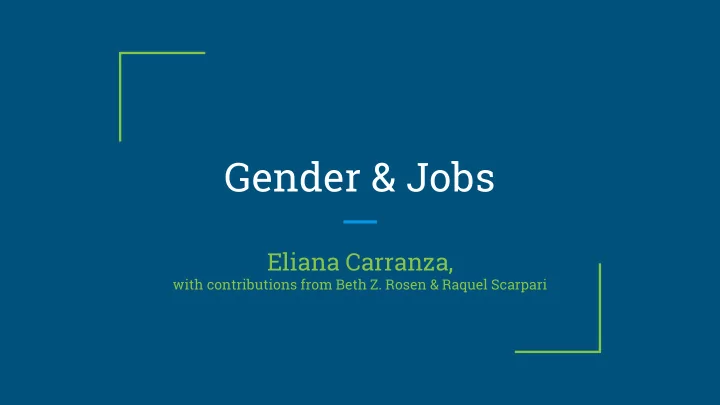

Gender & Jobs Eliana Carranza, with contributions from Beth Z. Rosen & Raquel Scarpari
Why does gender matter in the jobs agenda? ● Women comprise half of the world’s adults, and therefore potentially half of its labor force & workers Women’s participation in high return jobs is ● essential to achieving sustainable economic growth and household welfare But women face unique constraints that lead to ● suboptimal outcomes
Women are being left behind ● Lower labor force participation: ○ Women’s participation in the labor force is significantly lower than men’s in nearly every country 1 Lower employment: ● Fewer than half of women have jobs worldwide, compared with almost four- ○ fifths of men 2 Lower job quality: ● Women are more likely to work part-time, in informal jobs, in non-wage work, in ○ sectors/occupations with lower productivity and earnings, and to make less money than men 3 ● Worse outcomes for entrepreneurs: ○ Women- run business tend to be smaller than men’s, concentrated in traditionally female sectors, less profitable, grow more slowly, and are less likely to survive 4
What is holding women back? Legal discrimination, 1 including mandated restrictions for women opening a ● bank account, holding particular jobs, etc. ● Unpaid work responsibilities, such as childcare, which competes for their time Limited ownership of and access to assets (collateral) and thus lower ● financial access 2 And other constraints, including: ● Gender norms ○ ○ Differences in education, especially at the secondary level Limited professional networks and social capital ○ Labor market discrimination ○ ○ Safety concerns at work or while commuting
What are we doing to address these constraints in the jobs agenda? SOLUTIONS DIAGNOSTICS • • Development of analytical tools Policy Notes and working papers • • Specialized data (quantitative and Intervention and project design • qualitative) Impact evaluations M&E KM & COMMS • PARTNERSHIPS M&E instruments • • BBLs & Seminars Gender CCSA • • Publications TTLs (SPJ, FPD, T&C, AGR, GSU, EDU) • Jobs MDTF • Solutions for Youth Employment (S4YE) • KNOMAD • PEI COUNTRY WORK
What are we doing to address these constraints in the jobs agenda? Explore the specific gender issues at play in a given context ● ○ Gather and analyze relevant, gender-disaggregated and gender-sensitive data Identify country – specific priority areas for gender policy and action ○ ○ Review complementary literature to lay out what we do and do not know Consider and address the unique constraints faced by women 1 ● ○ Legal reforms when necessary to guarantee equality before the law Support for caregivers ○ Govt or private-sector provision of childcare/eldercare, government mandated paid family • leave, etc. Support women’s ownership of and access to key assets, such as land, housing, and ○ technology ○ Support women’s development of skills (non-traditional) Promote women’s financial inclusion ○
The WBG Jobs Group is innovating to address gender in the jobs agenda Jobs diagnostics ● Countries such as Bangladesh, Cote D’Ivoire, and Paraguay have conducted gender -informed ○ jobs diagnostics Nepal, Paraguay, and Pakistan are doing in-depth pilot work based on constraints identified ○ ● Jobs strategies Examines the creation of formal jobs, the quality of informal jobs, and access to jobs ○ ○ Qualitative research is underway in Paraguay on gender, youth, jobs, and migration Jobs operations ● ○ DPOs, PforRs, Finance for Jobs, Integrated Jobs Operations Unique operation design twists, such as bringing women’s parents to visit the workplace as a ○ way to address norms around women working in IT, implementing payroll management practices such as direct deposit as a way to increase women’s control over their earnings, etc.
Come talk to us about our other solutions! Eliana Carranza (ecarranza@worldbank.org) ● ● Beth Rosen (brosen1@worldbank.org) ● Raquel Scarpari (rscarpari@worldbank.org)
Recommend
More recommend